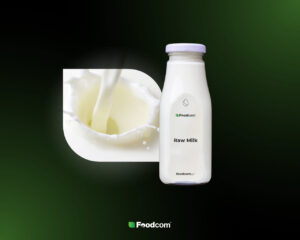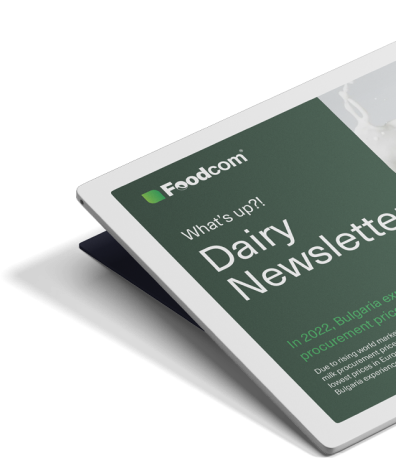- The European market for milk powder and cheese is struggling with oversupply and weak exports, which is putting further pressure on prices.
- The dairy fat segment is beginning to lose momentum, despite persistently high prices.
- Volatility and cautious purchasing dominate the market for liquids and whey, limiting sales opportunities.
- External factors, such as animal diseases in France and self-sufficiency programmes in Mexico, signal growing tensions in the global dairy chain.
Welcome Partners!
Welcome back to our newsletter!
The European dairy market is losing momentum – oversupply pressures and weakening exports are taking an increasing toll on prices and sentiment. In the milk powder segment, demand remains subdued, with rising stocks and unfavourable exchange rates adding to the stagnation. Cheese markets, with the exception of mozzarella, are struggling with high stocks and a lack of export momentum, resulting in further price easing. In the dairy fats market, we are seeing increasing signs of cooling, with butter and cream beginning to lose strength despite continued high levels. Volatility and caution are also prevalent in liquids and whey products, where oversupply and pent-up demand from Asia are limiting producers’ options. In parallel, there are signs of structural tensions from local sanitary restrictions in France to ambitions of dairy self-sufficiency in Mexico.
Scroll down for detailed market data and forecasts.
Milk powder
European SMP markets remain stagnant and show no signs of an imminent recovery. Weak export demand, exacerbated by an unfavourable EUR/USD exchange rate, means that buyers remain passive. Despite a 7.4% year-on-year increase in production in May, overall transaction volumes remain low and food SMP prices remain around 2300-2370 EUR/MT.
New Zealand SMP gained slightly in value at the recent GDT auction, indicating solid demand in Asia. However, in Europe, rising inventories and lack of external demand suggest continued oversupply. Meanwhile, in the US, lower FCMP and SMP production is helping to reduce storage loads and support price levels, helped by favourable export opportunities arising from the exchange rate.
European WMP prices continue to exceed expectations, settling around 4250 EUR/MT, although raw material pricing (SMP butter) suggests they should be closer to 4000 EUR/MT. Consumption remains volatile and demand from the chocolate industry is clearly weak.
Globally, New Zealand remains the benchmark for SMP prices. Recent GDT results reflect strong near-term demand from China, Southeast Asia and the Middle East. Given the strong outlook for the 2025/26 dairy season in Oceania and the high expected withdrawal levels, higher volumes are likely to come to market towards the end of the year, putting upward pressure on prices both in Europe and globally.
Cheese
The European cheese market remains fragmented. While mozzarella is benefiting from solid demand from the catering industry during the summer season, particularly in Southern Europe, most other cheese categories are facing price pressure due to high stocks and an uneven flow of exports. Spot bids for gouda and edam cheeses continue to weaken, with current average market prices around 4100-4250 EUR/MT, reflecting oversupply and a lack of short-term incentives to build up stocks. Mild cheddar prices remain stable, although average prices have fallen slightly in recent weeks, currently standing at around 4550-4600 EUR/MT, while mature cheddar continues to achieve higher prices due to Q4 contracts.
The best performer at the moment is mozzarella, whose Q3 spot and futures contracts have been secured above 4450 EUR/MT, thanks to lower supply and stable demand. This contrasts with the situation for cheddar and gouda cheeses, whose stocks remain high, especially in the UK and Ireland, and producers are aggressively reducing volumes to avoid a backlog in Q4.
In the US, the outlook is relatively positive. Despite some weakness in domestic consumption, US cheese exports have gained momentum thanks to a favourable price differential with products from Europe and Oceania. Total production remains strong, but cheddar cheese production has declined slightly year-on-year, while mozzarella continues to lead growth in response to strong global demand.
Fats
Butter prices in Europe are showing signs of weakening due to changes in fundamental factors. Production and imports are rising, while exports have fallen significantly. From January to April, the EU saw a surplus of 26 000 tonnes compared to 2024 and 6500 tonnes more than in 2023, indicating a reversal from last year’s shortage.
Although sentiment remains surprisingly stable, with buyers consistently returning 7000 EUR/MT, the market is showing a downward trend. Cream prices, which used to hover around 8900 EUR/MT, have fallen below 8000 EUR/MT as a result of the cooling weather, reducing upward pressure on butter prices.
In Oceania, butter remains globally sought after and competitively priced at around 6400 EUR/MT. The US market, although priced significantly lower (~4880 EUR/MT), is well supported by exports and limited cream availability due to the recent heatwave.
The AMF segment continues to be in a narrow price range. Buyers in both the industrial and export segments remain active, maintaining balance despite the surrounding volatility.
Liquids
Cream prices have fallen slightly, particularly in Central Europe, in response to milder temperatures and a more stable milk flow. In Western Europe, prices remain stable, but caution prevails as buyers assess spot market volatility.
SMC prices have recently increased, particularly for German high protein raw material (~2200 EUR/MT). French-origin SMC prices are slightly lower, but there is less availability of this raw material. The limited supply of raw milk and the preference for protein-rich ingredients continue to challenge processors’ margins, especially as production prices for cheese and powders lag behind.
Whey powder
The European whey powder (SWP) market is still not gaining momentum. The price of food grade whey powder is 980-1030 EUR/MT, while the price of feed grade whey powder remains at 800-850 EUR/MT. Over-supply and weak demand – especially from Asia – continue to have a negative impact on prices. Activity on the spot market remains low as producers prefer more profitable protein sources such as WPC and SWC.
WPC 80 prices remain stable at around 12 000 EUR/MT in the EU and 9200 EUR/MT in the US. Most of the volumes for Q3 have already been sold and producers are gradually raising offers for the end of Q3 and Q4. The US market has strengthened due to improved exports.
The WPI is showing renewed strength. European prices are at 19 600-20 000 EUR/MT, while US products are selling at around 18 000 EUR/MT. The price rebound reflects solid demand and expectations of lower availability later in the year.
Whey permeate prices remain low. European products are priced at around 800 EUR/MT, while much cheaper US products dominate export markets with prices at 480-500 EUR/MT. Low demand from Asia continues to put pressure on the market. Permeate prices remain weak in all regions. European bids are slowly declining, adjusting to more competitive US prices. Global demand remains low, particularly in Asia, putting pressure on prices in both regions.
The European lactose market is weakening after a stable spring. Although most volumes for Q3 have already been secured at higher levels, spot offers are being revised downwards. Prices in the USA, on the other hand, are supported by export interest, especially from Latin America and Southeast Asia. The sharp decline in imports from China (-58.5% y/y in May) continues to negatively impact the overall mood.
What’s new
France
France has reported the first case of lumpy skin disease (LSD) in cattle, detected at the end of June on a farm in the Savoie region. In response, the authorities introduced a 50-kilometre restriction zone covering several surrounding departments to stop the spread of the disease. LSD, a viral disease transmitted by biting insects, causes fever, skin lesions and decreased milk production in infected cattle. Although the disease does not threaten humans, it poses a serious threat to livestock health and trade, prompting authorities to take swift containment measures and increased control across the region.
Mexico
Mexico is stepping up efforts to achieve self-sufficiency in milk production through an ambitious programme by the Ministry of Agriculture to reduce reliance on milk powder imports from the US while increasing domestic production. Since mid-July, initiatives such as the reopening of long-closed processing plants in states such as Campeche and Michoacán, as well as direct purchases from local farmers under the ‘Milk for Wellbeing’ programme, offering a guaranteed price of around 11.50 pesos per litre, have been launched. With current production of around 13 billion litres, the government aims to reach 15 billion litres by 2030. – an increase of 15% – through subsidies, investment in infrastructure, technical support and measures to improve genetics and herd health. Despite these strong measures, industry experts warn that high production costs and structural constraints could make it difficult for Mexico to completely replace imports in the near term.
USA
The US continues to face a significant agricultural trade deficit, projected to reach almost $49.5bn in 2025. However, dairy represents a rare bright spot. In 2024, US dairy exports totalled $8.2bn, while imports totalled $5.4bn, resulting in a surplus of around $2.8bn. Growing international demand for cheese, dairy fat and high-protein whey from the US suggests that the surplus could rise to around $3bn in 2025, despite pressure from the overall trade imbalance.
![Oversupply and faltering exports – dairy markets in the shadow of the summer slowdown [277th Edition of DAIRY Bulletin] Oversupply and faltering exports – dairy markets in the shadow of the summer slowdown [277th Edition of DAIRY Bulletin]](https://foodcom.pl/wp-content/uploads/2023/08/Foodcom_Newsletter_Dairy-1520x760.jpg)


![Falling prices with rising costs – dairy in the midst of a seasonal solstice [276th Edition of DAIRY Bulletin] Falling prices with rising costs – dairy in the midst of a seasonal solstice [276th Edition of DAIRY Bulletin]](https://foodcom.pl/wp-content/uploads/2023/08/Foodcom_SA_Newsletter_Dairy-600x300.jpg)
![Dairy market in seasonal congestion – low activity and rising stocks [275th Edition of DAIRY Newsletter] Dairy market in seasonal congestion – low activity and rising stocks [275th Edition of DAIRY Newsletter]](https://foodcom.pl/wp-content/uploads/2024/06/Foodcom_SA_Dairy_Newsletter_4-600x300.jpg)
![Summary of the dairy market situation – key price developments [274th Edition of the DAIRY Newsletter] Summary of the dairy market situation – key price developments [274th Edition of the DAIRY Newsletter]](https://foodcom.pl/wp-content/uploads/2023/08/Foodcom_Dairy_Newsletter-600x300.jpg)

